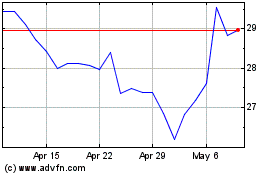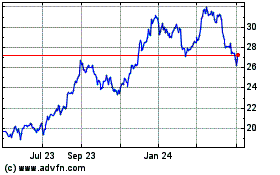UBS Global Real Estate Bubble Idx 2017: San Francisco is the most overvalued US urban housing market in the study; bubble ris...
September 28 2017 - 7:00AM
Business Wire
- UBS Wealth Management's UBS Global Real Estate Bubble Index
2017 report analyzes residential property prices in 20 select urban
areas around the world.
- Toronto faces the greatest risk of a housing bubble,
followed in descending order by Stockholm, Munich, Vancouver,
Sydney, London, Hong Kong, and Amsterdam.
- For buyers, San Francisco is the most overvalued US city in
the study, followed by Los Angeles. Boston and the New York metro
area are fair value, while Chicago is the only undervalued city in
the study globally.
Major urban housing markets in developed economies are still
overvalued, and more are at risk of a bubble than in 2016,
according to the annual Global Real Estate Bubble Index from UBS
Wealth Management's Chief Investment Office.
Toronto, a new entrant, tops the Index in 2017. As in
2016, Stockholm, Munich, Vancouver, Sydney, London, and Hong Kong
are also still at risk of a bubble, along with Amsterdam, which was
merely overvalued last year. The only undervalued city in the study
is Chicago, with three quarters of cities at risk of a
bubble or overvalued. San Francisco is the most overvalued
US city in the study, followed by Los Angeles. Boston
and the New York metro area are fair value.
Jonathan Woloshin, Co-Head of Americas Fundamental Research at
UBS Wealth Management's Chief Investment Office, said: "The
recovery in the US housing market following the bursting of the
housing bubble in 2007 has taken national home prices to new
heights. In our opinion, housing affordability is significantly
more challenged than conventional wisdom posits."
In San Francisco, in the wake of the technology boom and
buoyant foreign demand, real house prices have soared 65% since
2012. Price growth has slowed in recent quarters, but remains 6%
above the national average. Despite the thriving economy, average
incomes have risen only 10% since 2012 and have not kept pace with
house prices, worsening housing affordability further.
In Los Angeles, since 2012, real housing prices have
increased by 45%, while across the US the figure is just 23%. The
prospering economy and demand from China are fueling the boom and
show no sign of decelerating. Prices, however, are still 20% below
their 2006 peak. While income growth has escalated in the last two
years, housing affordability is stretched and should slow price
growth.
In the New York metro area, real prices rose by less than
3% in the past four quarters and are 10% higher than in 2013, when
the market bottomed out. The pace of price growth is only half the
national average. Manhattan house-price dynamics were much stronger
in the last couple of years, propelled by demand from global
investors and new luxury developments. But momentum has already
slowed in the high-end market.
In Boston, house prices increased by 6% last year and are
now 20% higher than in 2012. The regional economy and incomes are
growing faster than the national average. Housing affordability
remains good compared to other cities in the study. A 60 square
meter (650 square foot) flat costs only four annual household
incomes. As population growth remains vigorous and supply may be
slowing, prices should continue to rise.
In Chicago, since 2012, prices have risen by 15% in real
terms but remain 30% below their 2006 peak. Decreasing population,
sluggish employment and lackluster economic and income growth
hinder the recovery of broad-based demand in the housing market.
UBS Wealth Management expects price growth to lag behind the
national average in the coming quarters.
With respect to international markets, the outlook in
Europe is heating up. Claudio Saputelli, Head of Global Real
Estate for UBS Wealth Management's Chief Investment Office (WM
CIO), says: "Improving economic sentiment, partly accompanied by
robust income growth in the key cities, has conspired with
excessively low borrowing rates to spur vigorous demand for urban
housing." In the Asia Pacific region, Hong Kong and Sydney's
bubble risk have risen since last year. Singapore remains fairly
valued, with diminishing risks, while Tokyo has grown more
overvalued in 2017.
Superstars take all?
Expectations of long-term rising prices partly explain demand
for housing investment in major global cities. Many market
participants expect the best locations to reap most value growth in
the long run – the superstar model – buoyed by the growth of
high-wealth households. Falling mortgage rates over the last decade
have also made buying a home vastly more attractive. As long as
supply cannot increase rapidly, many buyers see "superstar city"
prices decoupling from rents, incomes and national price
levels.
The superstar narrative has received additional impetus in the
last couple of years from a surge in international demand,
especially from China, which has crowded out local buyers. An
average price growth of almost 20% in the last three years has
confirmed the expectations of even the most optimistic investors.
"This thesis has helped fuel overvaluation and even bubble risks in
most major urban housing markets in advanced economies globally,"
says Matthias Holzhey, Head of Swiss Real Estate for UBS WM CIO.
"Taking less risk in overheated markets has historically paid off
on average: they delivered worse returns over a full boom-bust
period than more balanced markets did."
For further information on the index, visit www.ubs.com/cio
About UBS
UBS provides financial advice and solutions to wealthy,
institutional and corporate clients worldwide, as well as private
clients in Switzerland. The operational structure of the Group is
comprised of our Corporate Center and five business divisions:
Wealth Management, Wealth Management Americas, Personal &
Corporate Banking, Asset Management and the Investment Bank. UBS's
strategy builds on the strengths of all of its businesses and
focuses its efforts on areas in which it excels, while seeking to
capitalize on the compelling growth prospects in the businesses and
regions in which it operates, in order to generate attractive and
sustainable returns for its shareholders. All of its businesses are
capital-efficient and benefit from a strong competitive position in
their targeted markets.
UBS is present in all major financial centers worldwide. It has
offices in 54 countries, with about 34% of its employees working in
the Americas, 35% in Switzerland, 18% in the rest of Europe, the
Middle East and Africa and 13% in Asia Pacific. UBS Group AG
employs approximately 60,000 people around the world. Its shares
are listed on the SIX Swiss Exchange and the New York Stock
Exchange (NYSE).
View source
version on businesswire.com: http://www.businesswire.com/news/home/20170928005413/en/
UBS Group AGMediaSwitzerland: +41-44-234 85 00UK:
+44-207-567 47 14Americas: +1-212-882 5857APAC: +852-297-1 82
00www.ubs.com
UBS (NYSE:UBS)
Historical Stock Chart
From Mar 2024 to Apr 2024

UBS (NYSE:UBS)
Historical Stock Chart
From Apr 2023 to Apr 2024
